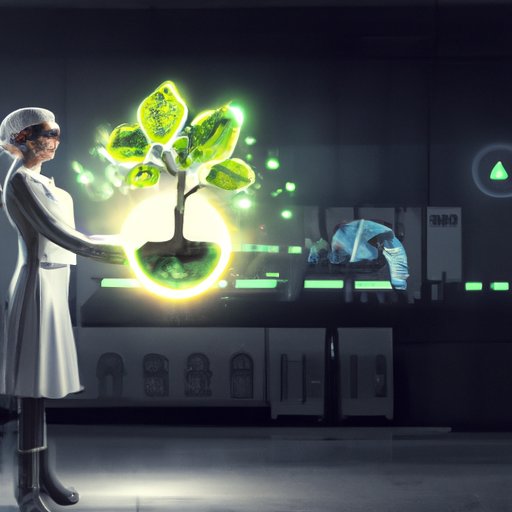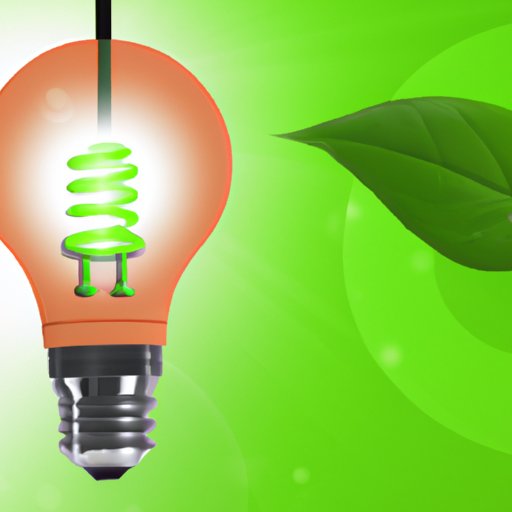Introduction
Green technology is an umbrella term that refers to technologies and practices that are environmentally friendly. It includes everything from renewable energy sources such as solar and wind power to more efficient methods of production and transportation. The goal of green technology is to reduce or eliminate the negative impacts of human activity on the environment.
The benefits of green technology are far-reaching and can have a positive impact on our daily lives, economies, and environments. In this article, we will explore these advantages in more detail.
Highlighting the Benefits of Green Technology in Everyday Life
Green technology has numerous advantages for everyday life. Here are some of the most notable benefits:
Increased Energy Efficiency
One of the most significant benefits of green technology is increased energy efficiency. According to the US Department of Energy, energy efficient products use less energy than traditional products while providing the same level of performance. This means that you can save money on your energy bills while also reducing your carbon footprint.
Reduced Costs
Green technology can also help you save money on other costs such as water bills and transportation costs. For example, water efficient appliances can reduce water consumption and thus lower your water bill. Additionally, electric cars are becoming increasingly popular as they are cheaper to maintain and run than traditional gasoline-powered vehicles.
Improved Health and Safety
Another benefit of green technology is improved health and safety. By using renewable energy sources such as solar and wind power, you can reduce your exposure to hazardous chemicals such as carbon dioxide and particulate matter, which can be present in traditional energy sources. Additionally, green technology can help reduce noise pollution, contributing to a quieter and healthier living environment.

Examining the Economic Impact of Green Technology
Green technology can have a positive effect on the economy as well. Here are some of the economic benefits of green technology:
Job Creation
Green technology can create new jobs in the clean energy sector. According to a report by the US Department of Energy, the clean energy sector employed over 3 million people in 2018. This number is expected to continue to grow as more businesses and individuals shift to green technology.
Stimulus to Local Economies
Green technology can also stimulate local economies by creating new businesses and industries. For example, the growth of the solar industry has created a demand for skilled workers and new manufacturing facilities. This has led to increased investment in local economies, creating jobs and stimulating economic growth.
Cost Savings
Finally, green technology can result in cost savings for businesses and consumers. For example, businesses that switch to renewable energy sources such as solar and wind power can save money on their energy bills. Additionally, individuals who switch to electric vehicles can save money on fuel costs.

Exploring the Environmental Impact of Green Technology
In addition to economic benefits, green technology can also have a positive environmental impact. Here are some of the environmental benefits of green technology:
Reduction of Carbon Dioxide Emissions
Green technology can help reduce carbon dioxide emissions, which are one of the primary drivers of climate change. According to the International Energy Agency, renewable energy sources such as solar and wind power are responsible for avoiding 1.5 gigatons of CO2 emissions each year. Additionally, electric vehicles can reduce greenhouse gas emissions by up to 50% compared to traditional gasoline-powered vehicles.
Protection of Natural Resources
Green technology can also help protect natural resources. For example, renewable energy sources do not require the extraction of fossil fuels, which can cause environmental damage when done improperly. Additionally, green technology can help conserve water by using water efficient appliances and systems.
Improved Air Quality
Green technology can also improve air quality. By switching to renewable energy sources such as solar and wind power, you can reduce your exposure to air pollutants such as sulfur dioxide and nitrogen oxide. Additionally, electric vehicles produce fewer emissions than traditional gasoline-powered vehicles, resulting in cleaner air.
Analyzing the Social Benefits of Green Technology
Green technology can also have a positive impact on society. Here are some of the social benefits of green technology:
Education and Awareness
Green technology can help educate and raise awareness about environmental issues. For example, businesses that embrace green technology can serve as role models and demonstrate to the public the importance of sustainability. Additionally, green technology can help create jobs in the clean energy sector, providing opportunities for education and training.
Improved Public Health
Green technology can also improve public health by reducing air and water pollution. According to a study by the World Health Organization, air pollution is responsible for 7 million premature deaths each year. By switching to renewable energy sources and electric vehicles, you can help reduce air pollution and improve public health.
Reduced Urban Sprawl
Finally, green technology can help reduce urban sprawl by encouraging sustainable development. For example, green buildings are designed to be energy efficient and use fewer resources than traditional buildings. This can help reduce the need for additional land and resources, which can help reduce urban sprawl.
Analyzing the Cost-Benefit of Green Technology
Green technology can also provide financial benefits. Here are some of the cost-benefit advantages of green technology:
Low Initial Cost
Green technology often requires a lower initial investment than traditional technology. For example, solar panels typically require a lower upfront cost than traditional energy sources such as coal and oil. Additionally, electric vehicles usually have a lower purchase price than gasoline-powered vehicles.
Long-Term Savings
Green technology can also result in long-term savings. For example, renewable energy sources such as solar and wind power can provide a steady source of free energy, resulting in significant savings over time. Additionally, electric vehicles require less maintenance than traditional gasoline-powered vehicles, resulting in lower repair costs.
Increased Value of Property
Finally, green technology can increase the value of property. According to a study by the National Renewable Energy Laboratory, homes with solar panels can sell for up to 4.1% more than comparable homes without solar panels. Additionally, green buildings may be eligible for tax credits, further increasing the value of the property.

Investigating the Role of Government in Promoting Green Technology
The government plays an important role in promoting green technology. Here are some of the ways in which the government can encourage the adoption of green technology:
Financial Incentives
The government can provide financial incentives to encourage businesses and individuals to adopt green technology. For example, the US federal government offers tax credits and rebates for investments in renewable energy sources such as solar and wind power. Additionally, many states offer grants and loans to businesses that invest in green technology.
Regulatory Standards
The government can also set regulatory standards to ensure that businesses and individuals are utilizing green technology. For example, the US Clean Air Act sets limits on the amount of pollutants that can be released into the atmosphere. Additionally, the US Environmental Protection Agency sets standards for energy efficiency in buildings and appliances.
Public Education
The government can also provide public education about green technology. For example, the US Department of Energy provides information about renewable energy sources, energy efficiency, and other topics related to green technology. Additionally, many states have programs to educate the public about the benefits of green technology.
Conclusion
Green technology has numerous benefits for our daily lives, economies, and environments. From increased energy efficiency and cost savings to improved health and safety, green technology can make a positive impact on our daily lives. Additionally, green technology can create jobs, stimulate local economies, and reduce carbon dioxide emissions. Finally, green technology can provide social benefits such as education and awareness and improved public health.
The government can play an important role in promoting green technology through financial incentives, regulatory standards, and public education. By investing in green technology, individuals and businesses can reap the rewards of reduced costs, increased energy efficiency, and improved environmental and social impacts.
(Note: Is this article not meeting your expectations? Do you have knowledge or insights to share? Unlock new opportunities and expand your reach by joining our authors team. Click Registration to join us and share your expertise with our readers.)
